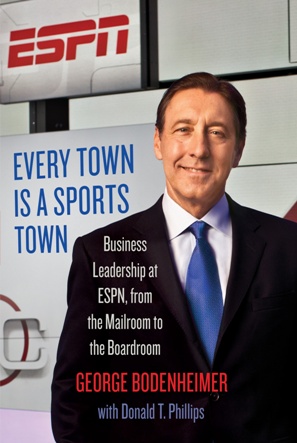Visits: 2
There are many people who feel at this point that ESPN is such a part of their lives, that it is a member of their family. In his new book, Every Town is a Sports Town: Business Leadership at ESPN from the Mailroom to the Boardroom, former ESPN President George Bodenheimer tells the story of how ESPN became so successful and what has kept them at the top of their game.
As is always done for reviews on this site dealing with sports books that cover a number of topics, this review will focus mainly on the parts of the book that intersect with baseball while also discussing the essence of the work.
 The main purpose of the book is to tell the career story of Bodenheimer. As the title suggests, he literally went from working in the mailroom at ESPN as his first real job out of college, to the boardroom as the president many years later. The story is refreshing because Bodenheimer was not given anything in his career, he earned it all and he didn’t come from an extremely privileged background that afforded him advantages to others in order to climb the ranks. His journey didn’t happen overnight either. Rather, Bodenheimer went from a mailroom worker to a driver to a salesman of cable rights in Texas to a promotion in sales in Chicago to running the sales office in Denver and finally back to Bristol, CT where he held various other positions before becoming president.
The main purpose of the book is to tell the career story of Bodenheimer. As the title suggests, he literally went from working in the mailroom at ESPN as his first real job out of college, to the boardroom as the president many years later. The story is refreshing because Bodenheimer was not given anything in his career, he earned it all and he didn’t come from an extremely privileged background that afforded him advantages to others in order to climb the ranks. His journey didn’t happen overnight either. Rather, Bodenheimer went from a mailroom worker to a driver to a salesman of cable rights in Texas to a promotion in sales in Chicago to running the sales office in Denver and finally back to Bristol, CT where he held various other positions before becoming president.
One of the keys to ESPNs success was making deals for live programming. In the early years, ESPN was showing any sport they could, even some that most Americans weren’t familiar with, but they were seeing that live sports, regardless of what they were, always drew ratings. One of these first such deals was with Major League Baseball. Very early on in their years, ESPN realized that if it could get a deal with MLB, it would be able to make some marks on the cable world. This was back when not all baseball games were televised on local networks. Instead, there were typically just a few games per week on the national networks (depending on who had what deal at the time). Their ability to grab a part of the MLB contract helped bolster them in the public’s eye.
One of the more interesting baseball related stories Bodenheimer tells in the book actually involves football. A staple of ESPN for many years had been Monday Night Baseball. The viewers had come to expect their delivery of baseball on that night and MLB loved having the primetime spotlight on itself every Monday night throughout the season. Having the game that night also typically meant that ESPN ran advertisements throughout the week to publicize the game, which MLB was also quite fond of. When ESPN won the contract for Monday Night Football, there became a problem.
ESPN had every intent of showing their new NFL game on Monday night despite the fact that in the month of September, baseball still had its season going, and were promised that same slot. ESPN knew they were going to have some frustrations from MLB, but they also figured moving the baseball game to ESPN2 while showing the football game on ESPN wouldn’t be too much of a big deal. Former commissioner of baseball Bud Selig vehemently disagreed with this logic and had a somewhat heated meeting with Bodenheimer to discuss his grievances. Despite Selig’s wishes, there was basically no way he could get ESPN to move Monday Night Football to ESPN2. Eventually the two sides agreed to disagree with some agreement on extra ways to publicize MLB.
The book is more than worth the read even if you are not a sports fan, but perhaps want to understand what makes one of the most well-known brands in the world so successful. Bodenheimer spends much of the book talking about the culture at ESPN and how it has been able to stay so strong over the years. He gives insider details about riffs that occurred through the years and gives particular attention to the years during which there were acquisitions such as when Disney acquired ESPN.
He also builds profiles of many now-famous ESPN personalities such as Chris Berman and Dick Vitale and gives the readers a behind the scenes look at these people, where they came from, and how their passion has helped drive the ESPN brand.
It is important to note that a few chapters of the book are spent on how the lives of many ESPN employees have been touched by cancer. As such, all profits from the book are donated directly to the V Foundation for Cancer Research. An in depth look of this charity can be found in the book as well.
Overall Rating: 4/5




One Comment
Pingback: …If You Liked That… | The Laurel
You must be logged in to post a comment Login